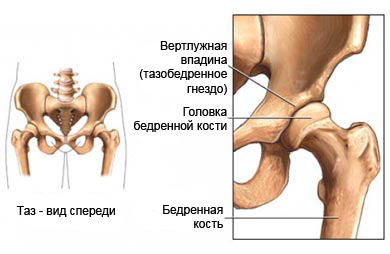Aseptic necrosis of the femoral head
Description of aseptic necrosis of the femoral head
Aseptic necrosis of the femoral head – death of bone tissue in the head of the femur due to insufficient blood supply.
Some bones may receive not enough blood. This can lead to tissue death. If the disease is not detected in time and treatment is not started, it will progress, causing bone deformities, pain and lameness.

Causes of aseptic necrosis of the femoral head
Any injury or illness, which damages arteries, which supply the femoral head increases the risk of avascular necrosis. The most common cases of fractures of the upper femur and hip dislocation. Other causes of decreased blood supply – blockage or compression of blood vessels.
There is a certain type of avascular necrosis of the thigh, called Legg-Calvé-Perthes disease , which affects the growth of the upper femur in children. This disease most often affects boys aged 5-10 years.
Risk factors for avascular necrosis of the femoral head
Factors, which increase the likelihood of avascular necrosis of the femoral head:
- Hip fracture;
- Dislocated hip;
- Radiation therapy;
- Prolonged or repeated use of cortisone (prednisolone, Dexamethasone) – Patients, taking doses of prednisolone less than 15-20 mg per day are at lower risk.
- Decompression sickness;
- Serpovidnokletochnaya anemia;
- Gaucher Bolezny;
- Excessive alcohol consumption;
- Systemic lupus erythematosus (SLE), especially when treated with corticosteroids;
- Kidney transplantation;
- HIV infection.
Symptoms of aseptic necrosis of the femoral head
Symptoms of avascular necrosis of the thigh are vague and may be caused by other, less serious problems.
- Groin pain, especially when lifting weights – the most common symptom;
- Buttock pain, hips, and knees;
- Claudication.
A small number of patients experience no symptoms.
Diagnosis of aseptic necrosis of the femoral head
The doctor asks about the symptoms and medical history, and performs a physical exam. Tests may include the following:
- Roentgen – to take a picture of structures inside the body, especially bones. When the disease is visible in the picture, it, usually, already has a developed form;
- CT scan – this type of x-ray examination uses a computer, to take pictures of structures inside the body;
- Radioisotope technetium bone scan – bone scan is very sensitive, but with a nonspecific test;
- MRT – this test uses magnetic waves, to make pictures of structures inside the body. This is the most useful test, which can detect the disease early enough, to start effective treatment.
Treatment of aseptic necrosis of the femoral head
Treatment options include the following:
Conservative treatment
Taking non-steroidal and other painkillers, and non-weight-bearing exercise may prevent or reduce progression of the disease.
Surgery
There are several surgical procedures, used to treat avascular necrosis of the thigh. The choice of surgery depends on the extent of the disease, patient's age and health status. Bone grafts, decompression of the inner part of the bone, hip replacement – procedures, which can be used to treat.
Prevention of aseptic necrosis of the femoral head
To reduce the likelihood of avascular necrosis of the thigh, you need to do the following:
- Reduce the dose and duration of medication, containing cortisone;
- Avoid decompression sickness while diving.
